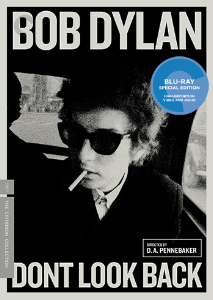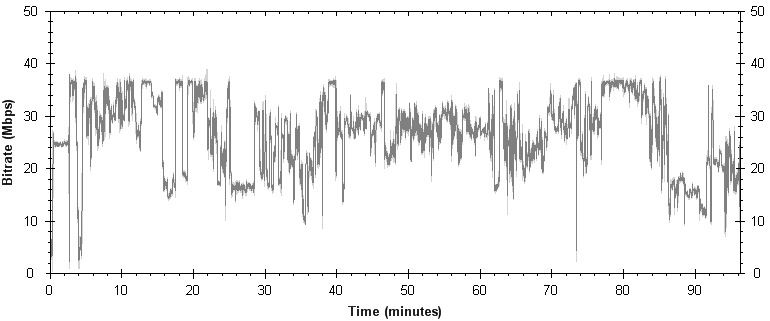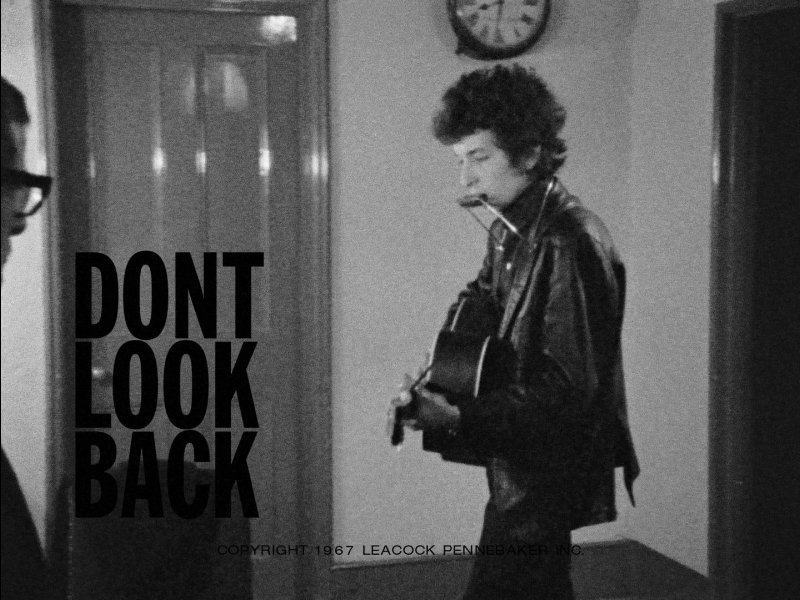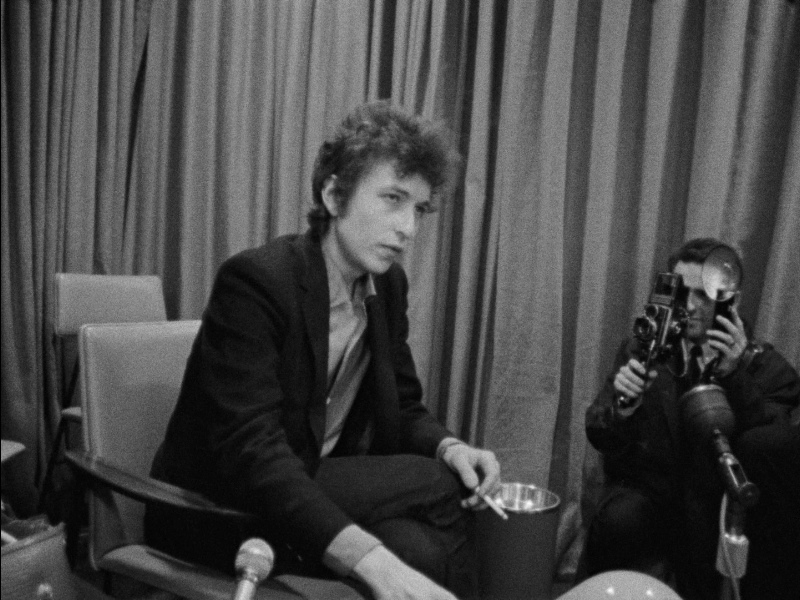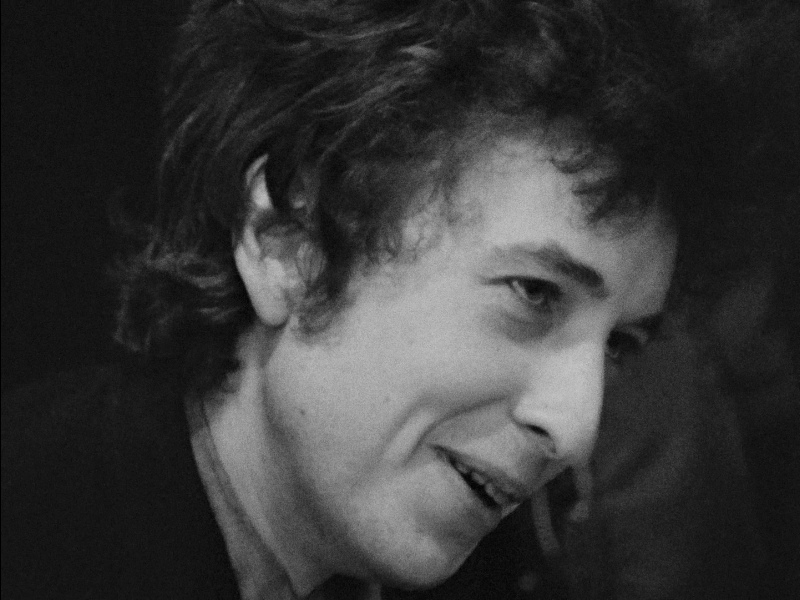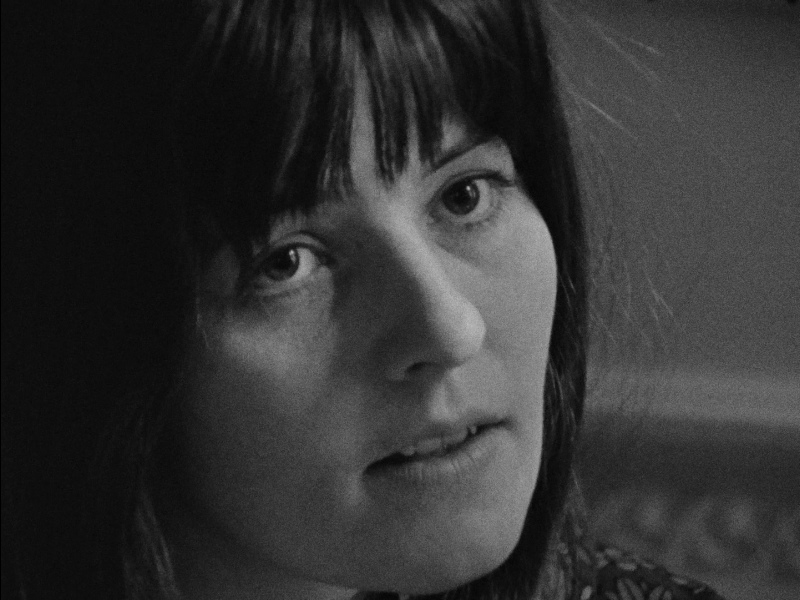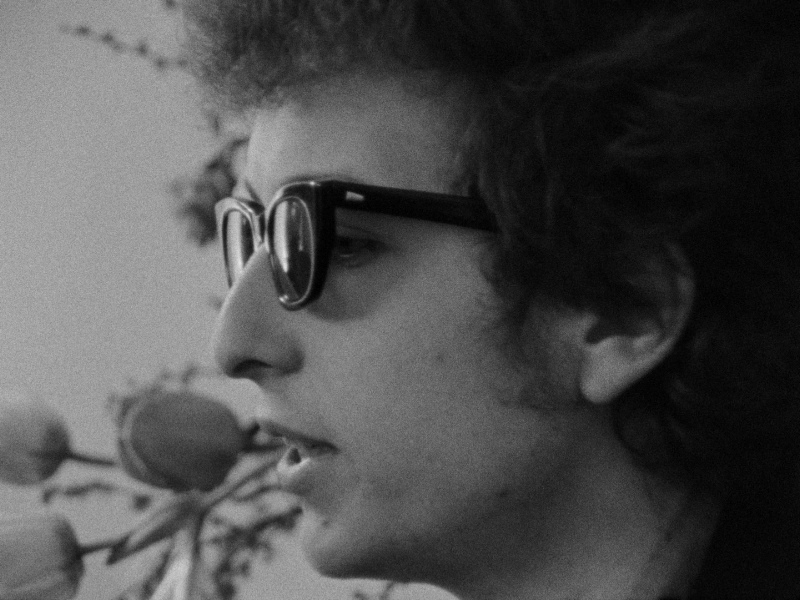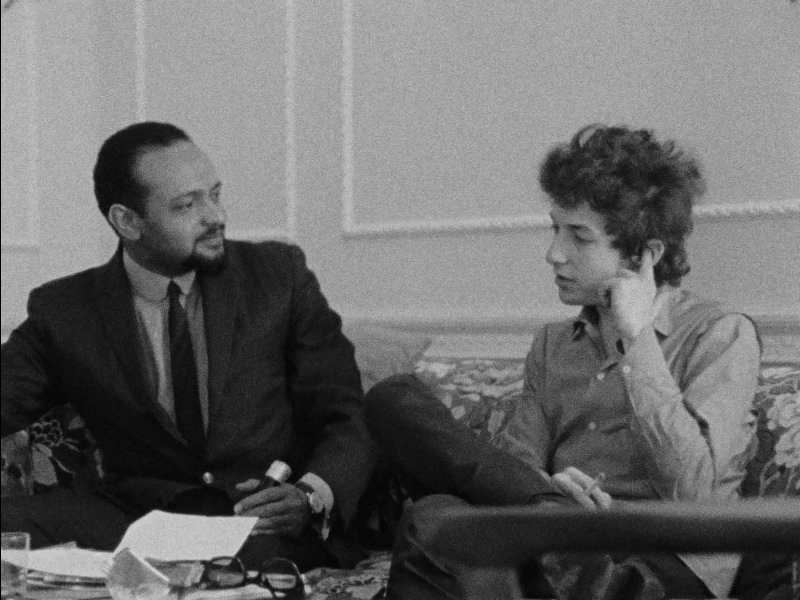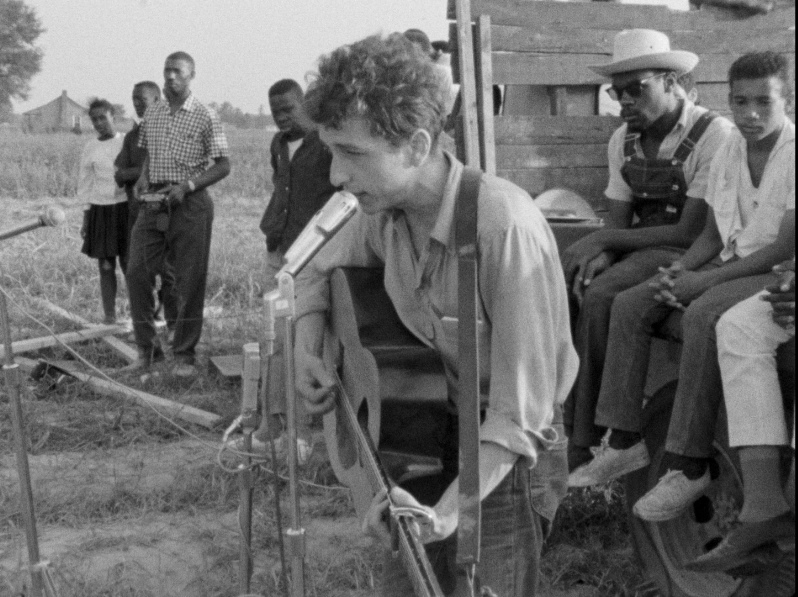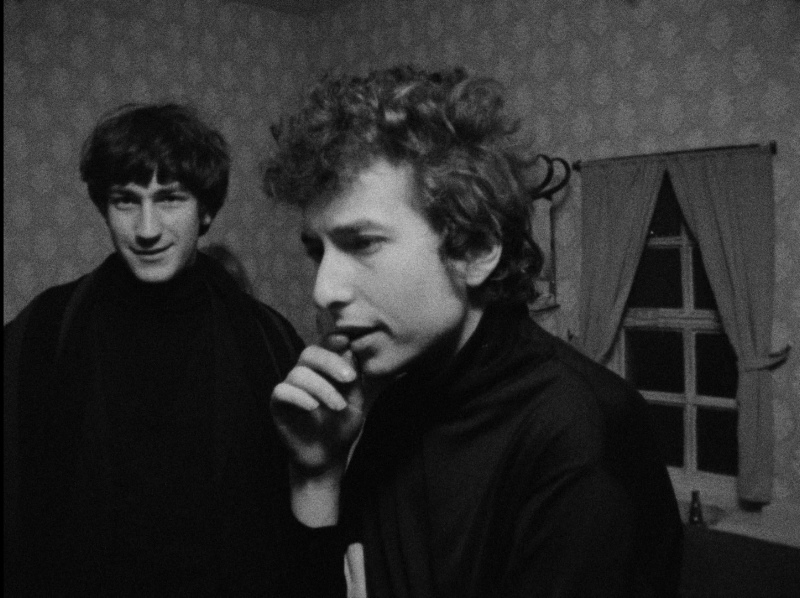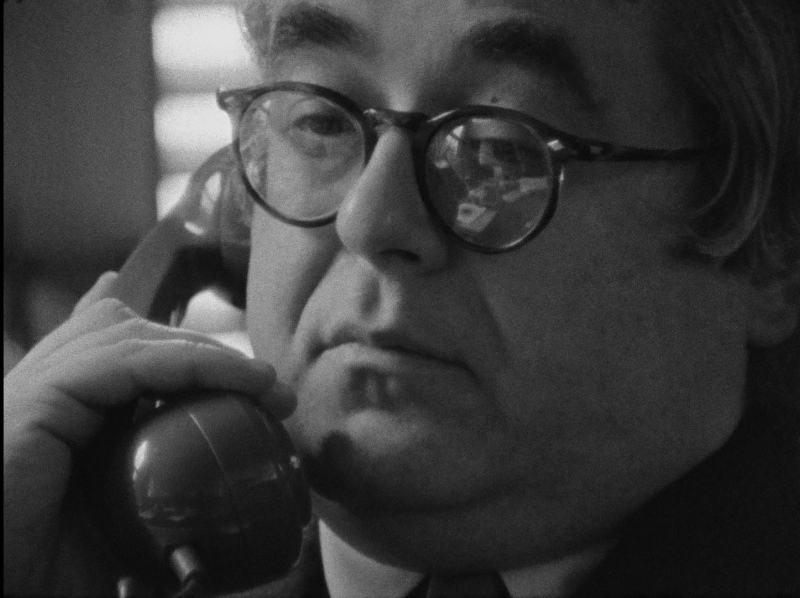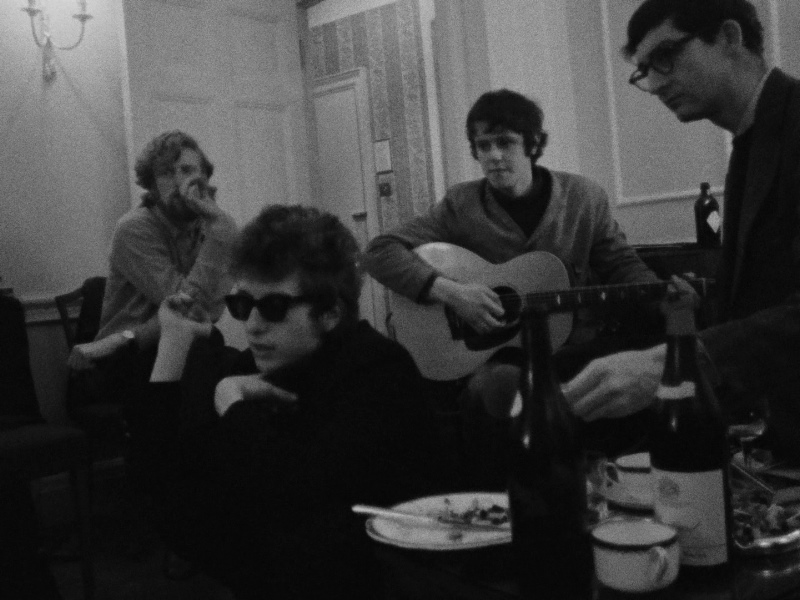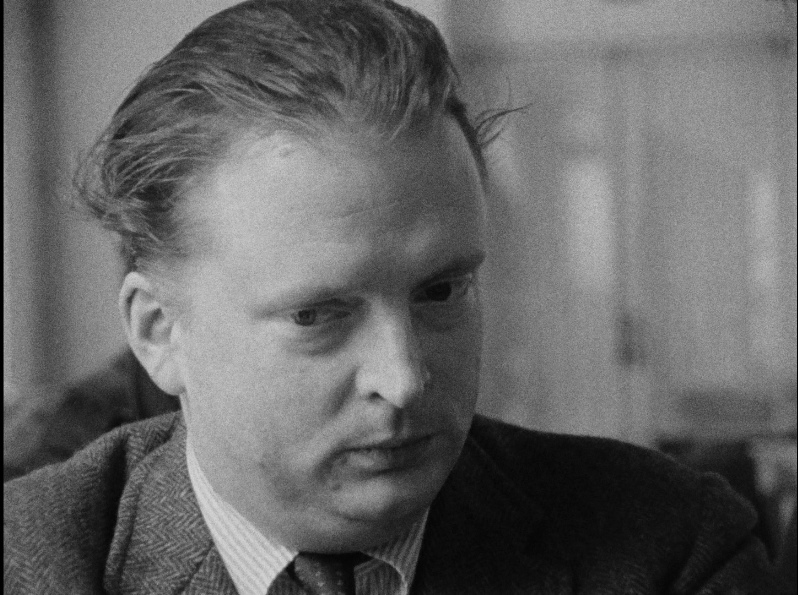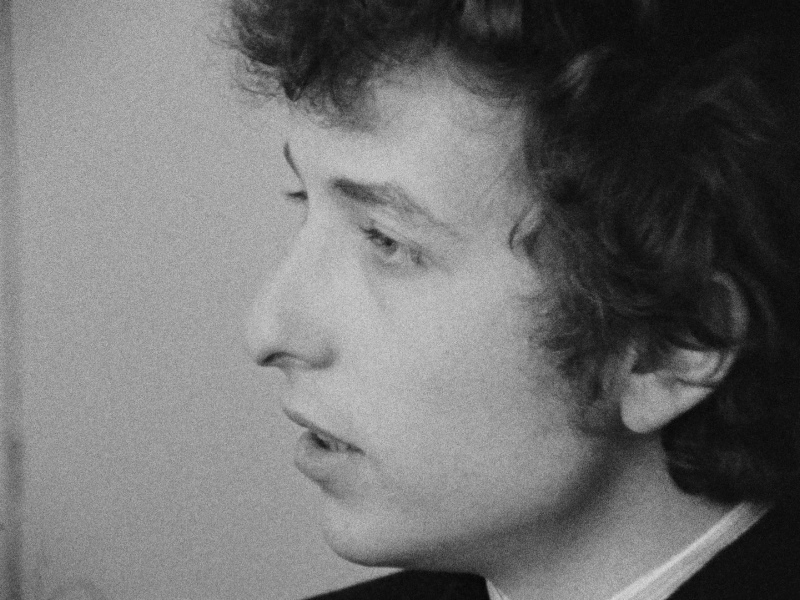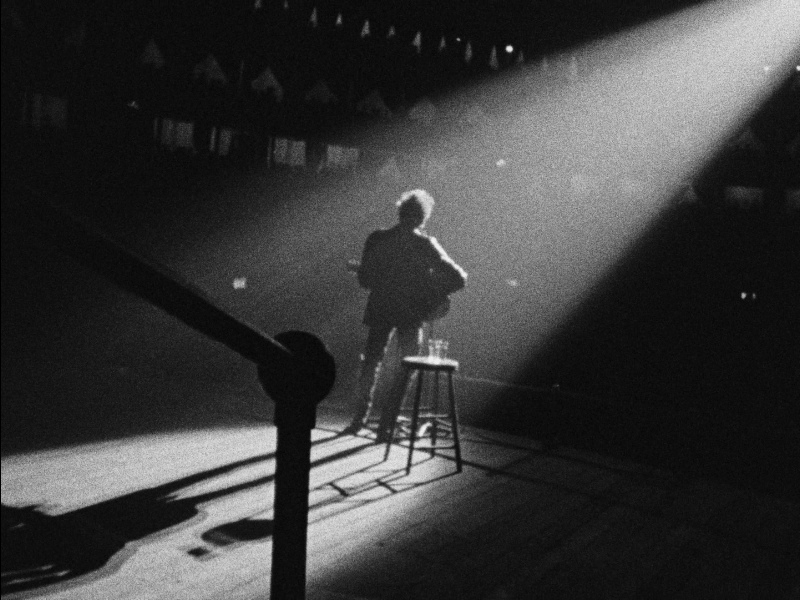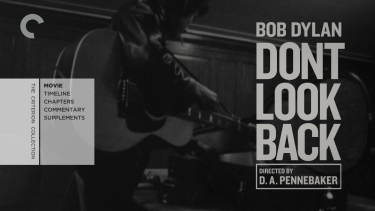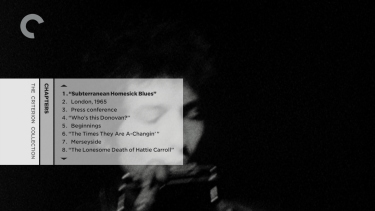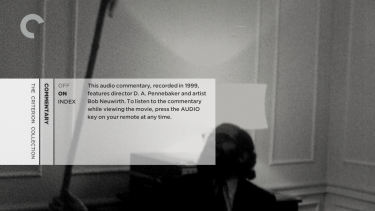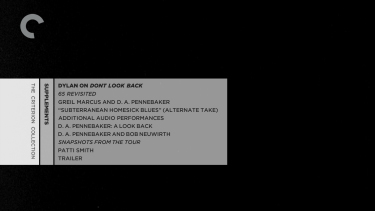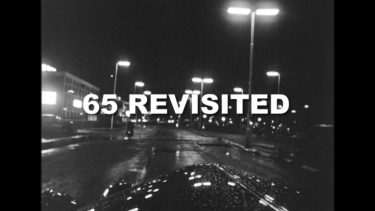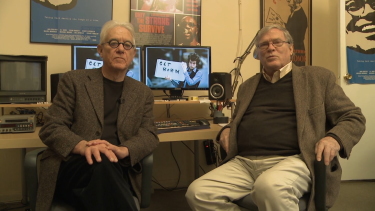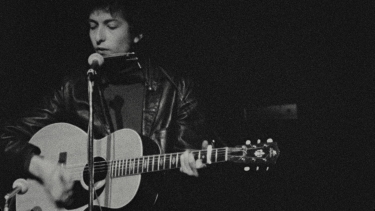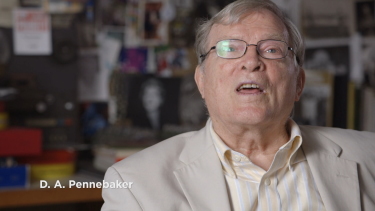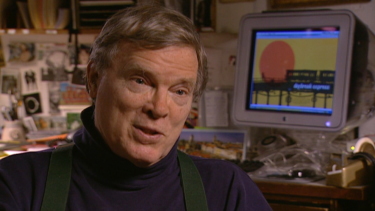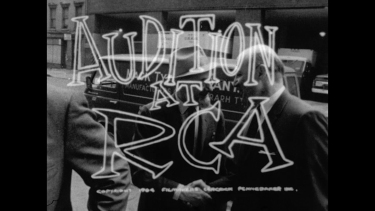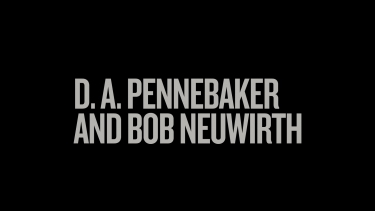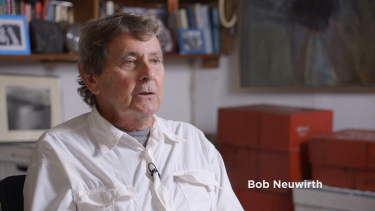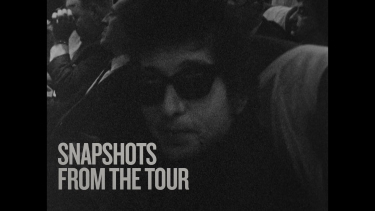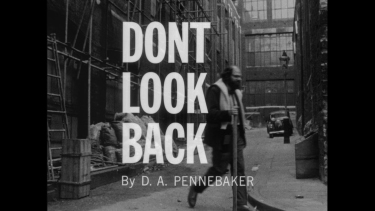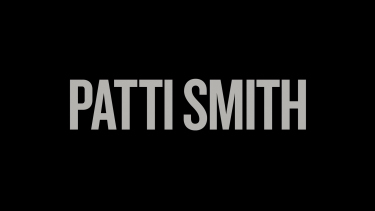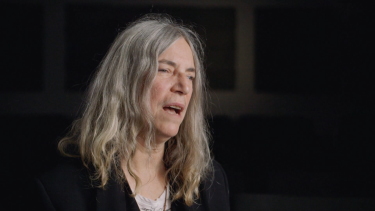![]()
![]()

![]()
![]()
|
Search DVDBeaver |
S E A R C H D V D B e a v e r |
|
|
Dont Look Back aka "Don't Look Back" [Blu-ray]
(D.A. Pennebaker, 1967)
Review by Gary Tooze
Production: Theatrical: Leacock-Pennebaker Video: Criterion Collection Spine #786
Disc: Region: 'A' (as verified by the Oppo Blu-ray player) Runtime: 1:36:15.519 Disc Size: 48,063,586,926 bytes Feature Size: 22,021,883,904 bytes Video Bitrate: 26.50 Mbps Chapters: 22 Case: Transparent Blu-ray case Release date: November 24th, 2015
Video: Aspect ratio: 1.37:1 Resolution: 1080p / 23.976 fps Video codec: MPEG-4 AVC Video
Audio: LPCM Audio English 1152 kbps 1.0 / 48 kHz / 1152 kbps / 24-bit Commentary: Dolby Digital Audio English 192 kbps 1.0 / 48 kHz / 192 kbps
Subtitles: English (SDH), none
Extras:
• Audio commentary from 1999 featuring Pennebaker and tour
manager Bob Neuwirth
•
It Starts With Music -
New documentary about the evolution of Pennebaker’s filming style
(29:05)
•
To Ramona (4:29) • Trailer (2:17) • Liner notes booklet featuring an essay by critic and poet Robert Polito
Bitrate:
Description: Bob Dylan is captured on-screen as he never would be again in this groundbreaking film from D. A. Pennebaker. The legendary documentarian finds Dylan in England during his 1965 tour, which would be his last as an acoustic artist. In this wildly entertaining vision of one of the twentieth century’s greatest artists, Dylan is surrounded by teen fans, gets into heated philosophical jousts with journalists, and kicks back with fellow musicians Joan Baez, Donovan, and Alan Price. Featuring some of Dylan’s most famous songs, including “Subterranean Homesick Blues,” “The Times They Are A-Changin’,” and “It’s All Over Now, Baby Blue,” Dont Look Back is a radically conceived portrait of an American icon that has influenced decades of vérité́ behind-the-scenes documentaries.
The Film:
I ain't lookin' to compete with you,

Image : NOTE: The below Blu-ray captures were taken directly from the Blu-ray disc. Don't Look Back on Blu-ray from Criterion is advertised as from a "new, restored 4K digital transfer, approved by director D. A. Pennebaker". It was shot in 16mm and looks beautifully rich with grain on this is dual-layered disc. Contrast is wonderful and I can't image the film looking any better for your digital consumption. There is no depth or noise and this representation seems to adhere to the authenticity of the original production roots. You can't ask for more.
CLICK EACH BLU-RAY CAPTURE TO SEE ALL IMAGES IN FULL 1920X1080 RESOLUTION
Audio :The audio is uncompressed via a 1.0 channel mono linear PCM and descried as "newly restored monaural sound from the original quarter-inch magnetic masters, presented uncompressed on the Blu-ray." It sounds very good, better than you might imagine - clear, tight, a pinch of depth and, obviously, flat. It is the best I have heard Dylan's music. There are optional English subtitles and m y Oppo has identified it as being a region 'A' disc.
Extras : In 2000 a company called Docudrama did a DVD release, HERE, of Don't Look Back. Criterion include some of the supplements found on that disc as well as many new ones. From Richard Malloy's review of that, older, DVD for DVDBeaver;
"Boasting a surfeit of riches, Docurama’s DVD easily surpasses the
minimum requisite features of the very special edition, making it an
essential document for any Dylanologist. So you wanna know the story
behind the glass fracas? You’ll get it here. What’s the deal with Alan
Price? Here ya go. Just where the hell did Joan Baez disappear to? Well,
you’ll need to read between the lines...
Not to be outdone - Criterion add plenty more. 65 Revisited is the 1-hour+ 2006 documentary directed by Pennebaker created from Don't Look back outtakes, edited by Walter Lamond, offering more footage from Bob Dylan's 1965 tour of England. We get a 2000 audio excerpt from an interview with Bob Dylan for the documentary No Direction Home, cut to previously unseen outtakes from Don't Look Back. It runs just shy of 4-minutes. There are three short films by Pennebaker; Daybreak Express (1953 - 5:24 / intro - 2:43), Baby (1954 - 6:00), and Lambert & Co. (1964 - 13:43). The first includes a short intro and was shot in 1953, though not completed until 1957, Daybreak Express was the first film D. A. Pennebaker made, a mad rush of images of New York City captures from a train and edited to the rhythm of Duke Ellington's some of the same name. The second, Baby, with his daughter at the Zoo - Pennebaker credits with giving him focus, and the latter, Lambert & Co., is a film of American Jazz vocalist Dave Lambert auditioning a new group of singers at RCA in 1964. Tragically Lambert was killed in an auto accident about two years after the session. It Starts With Music is a new 1/2 hour documentary about the evolution of Pennebaker’s filming style. It was made by Criterion and has director D.A Pennebaker and collaborators Jim Desmond, Nick Doob, and Chris Hedges looking back at Pennebaker's first cinematic steps, and how his choice of subjects and filmmaking style grew out of his interest in music and performance. There is a 1/2 hour conversation between Pennebaker and Neuwirth about their work together. Pennebaker first met Bob Neuwirth, Bob Dylan's 1965 tour manager, at New York City's Cedar Tavern before the tour began. After Don't Look back, in which he is often seen, Neuwirth became a ficture at Leacock-Pennebaker, Inc. and he worked on various projects with Pennebaker around that time, including recording sound when the director was asked to shoot Dylan's '66 tour determining which performances to record as part of the Monterey Pop team in '67. In this conversation the two reflect on those heady years. Snapshots from the Tour, is another new piece featuring never-before-seen outtakes from Don't Look Back. It runs 26-minutes and offers further glimpses into Dylan's '65 tour. Criterion add a new, 14-minute, interview with Patti Smith filmed in August 2015 where the musician discusses the role Bob Dylan played in her life, as well as tour manager Bob Neuwirth, who served as a mentor early in her career. There is a 2010 conversation between music journalist and cultural critic Greil Marcus and Pennebaker running almost 18-minutes. Lastly, we get a trailer and the package contains some liner notes in a booklet featuring an essay by critic and poet Robert Polito.
BOTTOM LINE: Gary Tooze October 19th, 2015
|
|
About the Reviewer: Hello, fellow Beavers! I have been interested in film since I viewed a Chaplin festival on PBS when I was around 9 years old. I credit DVD with expanding my horizons to fill an almost ravenous desire to seek out new film experiences. I currently own approximately 9500 DVDs and have reviewed over 5000 myself. I appreciate my discussion Listserv for furthering my film education and inspiring me to continue running DVDBeaver. Plus a healthy thanks to those who donate and use our Amazon links.
Although I never wanted to become one of those guys who
focused 'too much' on image and sound quality - I
find HD is swiftly pushing me in that direction. 60-Inch Class (59.58” Diagonal) 1080p Pioneer KURO Plasma Flat Panel HDTV PDP6020-FD
Oppo Digital BDP-83 Universal Region FREE Blu-ray/SACD
Player APC AV 1.5 kVA H Type Power Conditioner 120V Gary W. Tooze ALL OUR NEW FORMAT DVD REVIEWS
|
|
Footnotes 1Interview with D.A. Pennebaker by Nathan Rabin
http://www.theavclub.com/avclub3318/avfeature3318.html 2Pennebaker also accompanied Dylan on the 1966 tour, shooting footage
for the unreleased Eat the Document. Pennebaker discusses this in an interview
with Chris Buck
http://www.popped.com/articles98/cinemaverite/veritepennebaker.html
:
chris: So why isn't there a proper release of Eat The Document [also known as You Know Something is Happening] anywhere?
d.a.: Oh,
it was never my film, it was his (Dylan’s) film. He asked me to help him make
a film, he said, now I've
helped you
make your film, you help me make mine. You be the cameraman and I'll be the
director.
chris:
Wouldn't you be interested in releasing
something of it?
d.a.: For
me, it's very simple, it was always his movie, I helped him when I
could. In the end he aired it once
because a
person that worked with him that I knew, Howard Alt, they
edited a version that was peculiar.
chris:
People tend to think about it as your film.
d.a.: It's
my film in some ways because I shot it. That doesn't make a film your film,
the person controls how it looks finally,
the editing of it, the way it's released, all have a lot to do with how a
film exists and who it belongs to. There's
some fantastic things in that film. In a way I'm sad a little bit because
stuff that I think is fantastic will never be
seen. But I always have the feeling that ultimately it will. Sooner or later
everybody finds out everything.
If an until Eat the Document is released, the best
way to experience the 1966 tour is the Columbia CD release of LIVE 1966: The Bootleg Series Vol. 4,
a complete live recording of the Manchester show (which, for decades, was
mislabeled as ‘the Royal Albert Hall show’ on the various circulating
bootlegs).
Other
recommended resources:
·
What Has Become of Cinéma
Vérité Since Don’t Look Back,
by William Rothman, PhD http://www.humanities.org/port/Archive/0720-rothman.html · Pennebaker Biography/Filmography at IMDb http://us.imdb.com/Name?Pennebaker,+D.A.
|
![]()
![]()

![]()
![]()

